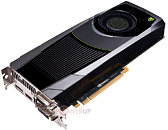- Joined
- Oct 9, 2007
- Messages
- 47,593 (7.45/day)
- Location
- Dublin, Ireland
| System Name | RBMK-1000 |
|---|---|
| Processor | AMD Ryzen 7 5700G |
| Motherboard | Gigabyte B550 AORUS Elite V2 |
| Cooling | DeepCool Gammax L240 V2 |
| Memory | 2x 16GB DDR4-3200 |
| Video Card(s) | Galax RTX 4070 Ti EX |
| Storage | Samsung 990 1TB |
| Display(s) | BenQ 1440p 60 Hz 27-inch |
| Case | Corsair Carbide 100R |
| Audio Device(s) | ASUS SupremeFX S1220A |
| Power Supply | Cooler Master MWE Gold 650W |
| Mouse | ASUS ROG Strix Impact |
| Keyboard | Gamdias Hermes E2 |
| Software | Windows 11 Pro |
We know from a late-March article that NVIDIA is working on two new SKUs based on its GK104 silicon, for launch in May. With the Kepler architecture, particularly with the design of the new-generation Streaming Multiprocessors (SMX), NVIDIA substantially increased CUDA core density. Each SMX holds 192 CUDA cores, and as with the previous-generation Fermi architecture, the SMX count is the only thing NVIDIA can tinker with, to control CUDA core count in new GPUs. GeForce GTX 680's little brother, hence will have 7 out of 8 SMX units enabled, and end up with a CUDA core count of 1344. This leaves easier to configure parameters such as clock speeds, for NVIDIA to design the perfect SKU to capture a price-point. NVIDIA is targeting the sub-$399 market, while somehow maintaining competitiveness with Radeon HD 7950.

Specifications of the new SKU follow.
GeForce GTX 670 Ti, by the numbers
View at TechPowerUp Main Site

Specifications of the new SKU follow.
GeForce GTX 670 Ti, by the numbers
- 4 Graphics Processing Cores (GPCs), 7 Streaming Multiprocessors (SMX)
- 1344 CUDA cores
- 112 Texture Memory Units (TMUs), 32 Raster Operation Processors (ROPs)
- 256-bit wide GDDR5 memory interface
- Around 900 MHz base core clock, boost clock and feature availability not known
- Around 1250 MHz (5.00 GHz GDDR5 effective) memory clock, around 160 GB/s memory bandwidth
- Estimated price US $349-399
View at TechPowerUp Main Site
Last edited:



 .
.




